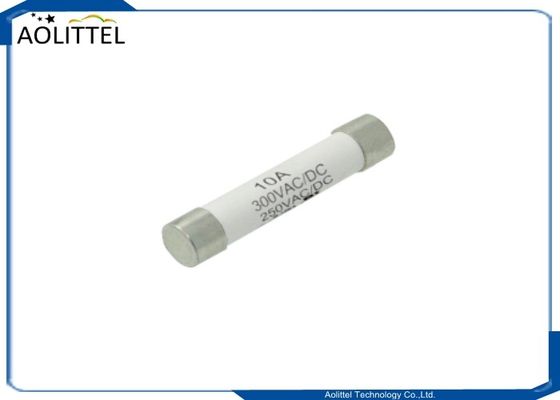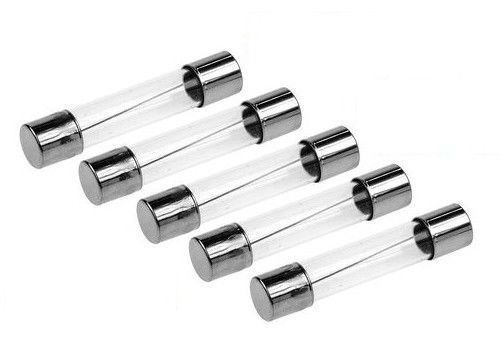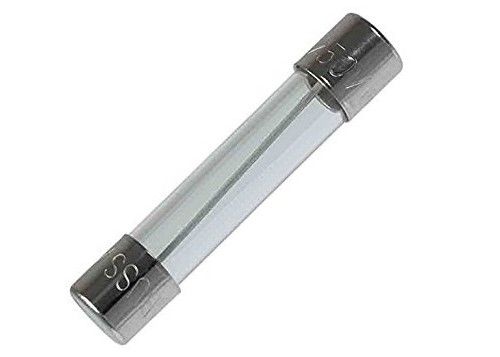Cigar Lighter Cartridge Fuse Ferrule 6.35x32mm Time Delay Time Lag Slow Blow Glass Tube Fuse 10Amp 250VAC 6x30mm
Overview
The Aolittel MTC Slo-Blo

w fuse solves a broad range of application requirements while offering reliable performance and costeffective circuit protection.
Guesswork and time consuming circuit testing are eliminated. This unique design offers the same quality performance characteristics as the standard MTCSlo-Blow

Fuse design.
___________________________________________________________ Download________
Download________
Features
• In accordance with UL Standard 248-14
• Available in cartridge and axial lead format and with various forming dimensions
• RoHS compliant and Lead-free
Application
Used as supplementary protection in appliance or utilization equipment to provide individual protection for
components or internal circuits.
Specification
A=250V,B=125V
|
Part
No.
|
Ampere
Rating
|
Voltage
Rating
|
Breaking
Capacity
|
I2TMelting
Integral(A2.S)
|
| MTC0100A/B |
100mA |
250V/125V |
10000A@125 V AC (100mA~10A);
35A@250V AC (100mA~1A);
100A@250V AC (1.25A~3.5A);
200A@250V AC (4A~10A).
|
0.028 |
| MTC0160A/B |
160mA |
250V/125V |
0.075 |
| MTC0200A/B |
200mA |
250V/125V |
0.12 |
| MTC0250A/B |
250mA |
250V/125V |
0.15 |
| MTC0300A/B |
300mA |
250V/125V |
0.19 |
| MTC0315A/B |
315mA |
250V/125V |
0.22 |
| MTC0350A/B |
350mA |
250V/125V |
0.29 |
| MTC0400A/B |
400mA |
250V/125V |
0.28 |
| MTC0500A/B |
500mA |
250V/125V |
0.52 |
| MTC0630A/B |
630mA |
250V/125V |
0.87 |
| MTC0750A/B |
750mA |
250V/125V |
1.1 |
| MTC0800A/B |
800mA |
250V/125V |
1.4 |
| MTC1100A/B |
1A |
250V/125V |
3.5 |
| MTC1125A/B |
1.25A |
250V/125V |
7.6 |
| MTC1150A/B |
1.5A |
250V/125V |
9.1 |
| MTC1160A/B |
1.6A |
250V/125V |
13 |
| MTC1200A/B |
2A |
250V/125V |
20 |
| MTC1250A/B |
2.5A |
250V/125V |
39 |
| MTC1300A/B |
3A |
250V/125V |
61 |
| MTC1315A/B |
3.15A |
250V/125V |
56 |
| MTC1350A/B |
3.5A |
250V/125V |
70 |
| MTC1400A/B |
4A |
250V/125V |
104 |
| MTC1500A/B |
5A |
250V/125V |
148 |
| MTC1600A/B |
6A |
250V/125V |
173 |
| MTC1630A/B |
6.3A |
250V/125V |
192 |
| MTC1800A/B |
8A |
250V/125V |
380 |
| MTC2100A/B |
10A |
250V/125V |
580 |
| MTC2120A/B |
12A |
250V/125V |
723 |
| MTC2150A/B |
15A |
250V/125V |
934 |
| MTC2200A/B |
20A |
250V/125V |
1280 |
| MTC2250A/B |
25A |
250V/125V |
1678 |
| MTC2300A/B |
30A |
250V/125V |
2036 |
Electrical Characteristics by Series
|
% of Ampere Rating(In)
|
Blowing Time
|
| 100%* In |
4 hours Min |
| 135%* In |
1 hour Max |
| 200%* In |
120 sec Max |
Dimension (mm)



Product Characteristics
| Material |
Body: Glass
Cap: Nickel–plated brass
Leads: Tin–plated Copper
|
| Terminal Strength |
MIL-STD-202, Method 211, Test Condition A |
| Solderability |
MIL-STD-202 method 208 |
| Product Marking |
Cap1: Brand logo, current and voltage ratings
Cap2: Series and agency approval marks
|
| Operating Temperature |
–55ºC to +125ºC |
| Thermal Shock |
MIL-STD-202, Method 107, Test Condition B: (5 cycles -65°C to +125°C) |
| Vibration |
MIL-STD-202, Method 201 |
| Humidity |
MIL-STD-202, Method 103, Test Condition A: High RH (95%) and Elevated temperature (40°C) for 240 hours |
| Salt Spray |
MIL- STD-202, Method 101, Test Condition B |
Difference Between Ceramic & Glass Fuses

A fuse protects electrical appliances and equipment by breaking the electrical circuit in the event of an overload of current or a short circuit. There are a number of different types of fuses available, and these differ in size, shape and material. Ceramic and glass are two common materials used to make fuses.
How Fuses Work
When a fault occurs, such as an overload or short circuit, the high current that is flowing through the fuse melts the fuse element, thus interrupting the flow of current and breaking the circuit. This prevents the appliance from damage due to excess current.
History
The earliest fuses were no more than simple open wires introduced in an electrical circuit to break the flow of current when necessary. The first enclosed fuse was created by Edison in 1890. Since then, the fuse has developed and diversified into many different types.
Types
Though the purpose of all fuses, whether ceramic or glass, is the same, each has a unique manner of functioning and a unique response to an overload of current. The fuses available are very fast acting fuses (FF), fast-acting or quick-blow fuses (F), medium-acting or semi-delay fuses (M), slow-blow, time-lag or time-delay fuses (T) and very-slow-acting, long-time-lag or super-time-lag fuses (TT).
Each fuse responds differently to current flow and surges, and takes a different amount of time to react; it is therefore important to choose the correct fuse for the circuit it is to be introduced in. An incorrect fuse could either mean no protection because it has not melted in time, or oversensitivity when it blows repeatedly for no real reason. For example, if an FF fuse is fitted in a circuit with an appliance that creates a current surge when it is first switched on, the fuse would blow even though there is no threat. Typically, for a 500 percent overload, an FF fuse would take one-tenth the time of a normal F fuse to blow, while a T fuse would take up to 200 times longer.
Construction
A fuse body is made of glass, ceramic, plastic or fiberglass. The body is called the barrel, and it has a terminal made of plated copper or brass at each end. These terminals are connected by the fuse element, which is made of copper, aluminium, zinc, or silver. The element could either be a single wire, or consist of more than one wire. The multiple wires could be arranged in different ways to make the fuse behave differently. Sometimes, sand or quartz powder is filled in the body to alter the behavior of the fuse. This is usually the case in a ceramic fuse.
Differences
In a glass fuse, the element is visible, and this makes inspection easy, while a ceramic fuse is opaque. A glass fuse has a low breaking or rupturing capacity. What this means is that the fuse element melts when there is a high current or voltage. It is therefore not suitable for appliances and equipments that draw a lot of current. Ceramic fuses, on the other hand, have a high breaking or rupturing capacity and are suitable for high current and voltage circuits. Some ceramic HRC (high rupturing capacity) fuses can safely interrupt upto 300,000 amperes of current, while normal glass fuses have a much lower capacity, sometimes as low as only 15 amperes.
Glass fuses have a low thermal stability and shatter in high-heat conditions. Ceramic fuses, on the other hand, can withstand high temperatures and are more thermally stable. Ceramic fuses, unlike glass fuses, are also often filled with a filler like sand to prevent the formation of a conductive film. When there is a short circuit, the fuse element melts and vaporizes. It deposits on the inside of the barrel or body as a film. In a glass fuse, the body continues to get heated and the film begins to conduct electricity, thus rendering the fuse inefficient. The sand in a ceramic fuse, however, absorbs the heat energy and prevents the fuse from heating and therefore conducting.
Considerations
It is important to consider these factors before installing a fuse: the maximum continuous current rating, which indicates the maximum current that can pass through a fuse; the rupturing or breaking capacity, which indicates the maximum current that can be interrupted without causing damage; the voltage rating--the fuse must be used at less than the rated voltage.
Warning
Ensure you choose the right fuse for your appliances and equipment to protect them and to reduce the risk of overheating and fire. If you are unsure, speak to an electrician.

 Your message must be between 20-3,000 characters!
Your message must be between 20-3,000 characters! Please check your E-mail!
Please check your E-mail!  Your message must be between 20-3,000 characters!
Your message must be between 20-3,000 characters! Please check your E-mail!
Please check your E-mail! 














